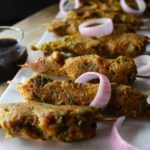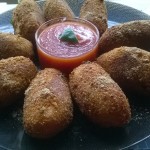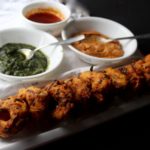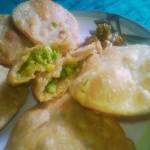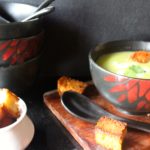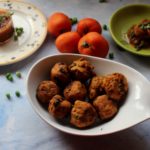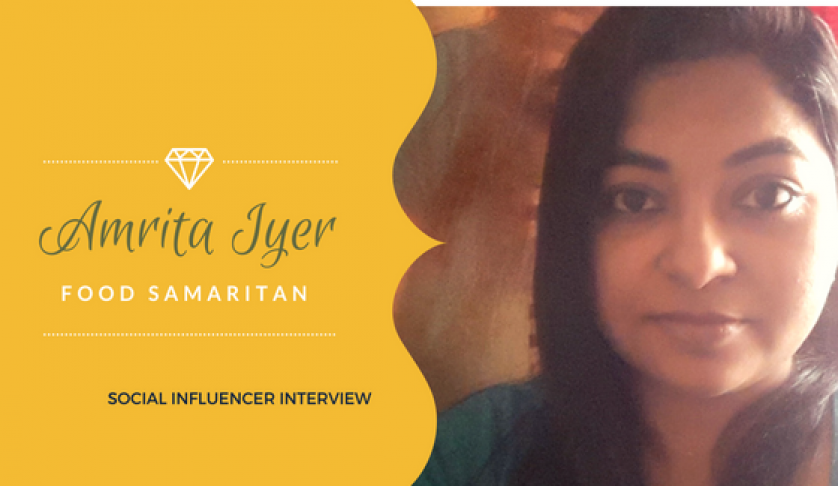Arbi,Taro or Colocasia – call this starchy vegetable by whatever name you want ,is truly one of the blessings of nature!The vegetable is an “under the ground” tuber like the potato,but narrower in shape having a scaly brown or black skin on it.When boiled the skin forms a coarse peel which slips off easily from the inside “pulp”.On the inside its a creamish white slippery substance quite unlike the potato which has a thin peel and firm texture.In Canadian Supermarkets I used to get what was known as “Eddos”-a cousin for Taro with a similar taste!!The Arbi is a diverse vegetable which is used like the potato in different versions like curries,snacks,side dishes,appetisers and more recently the “Pakoda” craze which has enveloped my family.An aunt of mine recycled leftover Arbi into Pakodas and everyone went Ga-Ga over it!Will be posting that shortly!But OHH..the leaves ……they are edible too!!These leaves shaped like elephant ears are very tasty when cooked.
In Uttar Pradesh The Arbi Leaves are used in “subzis” – plain or with potatoes as they generally do with green leaves.Its also used in soups and as “serving platters” for appetizers in marriages.the leaves are big and with thick brown stems.My friend in Kanpur once used them to stuff parathas and ohh!!What delicious Parathas…waiting to try them out soon!
In Gujarat they are made into a delicious snack called Paatra.They are called Alou Wadi in Mumbai(as was discussed by a good friend of mine) which I did not know till now.I was told of this dish by my late Grandmother who was a native of Mumbai after marriage.They used to stay in front of the famous Shivaji Park in Dadar.She told me that near the beach very near to their residence,there used to sit a “Bajjiwala”-meaning a Pakodawala who used to make assorted Pakodas – potato,brinjal,raw banana,cauliflower and even stuffed bread pakoda.He used to sell approx 40 pakodas for an “anna” which was a resonable “sum” of money those days!He also used to make the Paatra which was a huge hit.He used to sell it in cardboard boxes(like the sweet boxes) for 2 annas per 500 gms. She asked him for the recipe and made it a couple of times though not with me as colocasia leaves were quite rare in the part of Lucknow where I lived.This is her version – and this dish dedicated to her….!!
Preparation Time – 30 minutes
Makes – Approx 30 Paatras
Ingredients
9 Colocasia Leaves – washed and drip dried.
For the gram flour paste:
2 cups gram flour/garbanzo bean flour(besan)-sifted
Salt to taste
1 tsp chilli powder
1 tsp ginger paste
1/2 tsp asafoetida
1/2 tsp turmeric powder
3 tsp tamarind paste/1 tbsp tamarind soaked in water
2 tbsp jaggery/brown sugar- powdered
For the tempering:
2 tsps oil
1 tsp mustard seeds
2 tsp sesame seeds
1/2 tsp asafoetida
For the garnish:
1 tbsp coriander leaves
1 tbsp grated coconut(optional)
Method
Mix the tamarind paste with 2 tbsp water and add the jaggery/brown sugar to it.Let it rest till the jaggery dissolves.If using soaked tamarind then strain the water and add the jaggery to it.Let it rest till it dissolves.Wash the Colocasia leaves very well and drip dry them ensuring they do not tear.
Mix all the ingredients for the paste and add the tamarind water.Be very careful here.We do not want a thin batter.It should be thick enough like a paste..NOT like a batter.Arrange the Colocasia leaves as per size starting from the largest.For each roll take 3 leaves at a time so that you will have 3 big rolls or 6 small rolls(cut in half).Put the first leaf on a chopping board.Turn it over where it is lighter green in color.You will see the long brown thick stem which joins with the veins of the leaf.Take a sharp knife and very carefully cut away the stem,starting from the point where it meets the leaf to approx the mid-section.Prepare all the leaves in this way.
Now arrange the leaves in batches of 3’s.Remember to always put the biggest leaf first.Put the first leaf on a plate.With your hand smear the gram flour paste over the leaf.You can always do this with a silicon brush but the effect will not be as good.I know its messy work..but the result is well worth the effort!!
Put the second leaf – same way..upside down over the first and smear with paste.Now put the final leaf on top.Start rolling from the 2 ends – above the stem into a very tight roll.
It was too long to go into my steamer so I cut it in half and made 2 rolls.
Make rest of the rolls the same way.Grease a “Thaali” with 1 tsp oil.Put the rolls on the “Thaali” and heat a steamer with 1 cup water on high heat.Insert a small “Katori” or steel cup or bowl also filled with water into the steamer and place the “Thaali” on it.Once the water starts boiling,close the lid.
After placing the lid on reduce to low heat an steam for 20-25 minutes till the Patras as well as the besan are steamed thoroughly!!
After 25 minutes take off heat and allow to cool before opening the steamer.
Cut the Paatras into slices on a chopping board.
Keep the slices on a plate.
Add the Paatras carefully and mix them gently with the “Tadka”.
Saute for 5 minutes and take out in a serving bowl or plate.Garnish with coriander leaves and grated coconut!
Best had with a mug of hot ginger tea.Makes an evening worth enjoying!!



